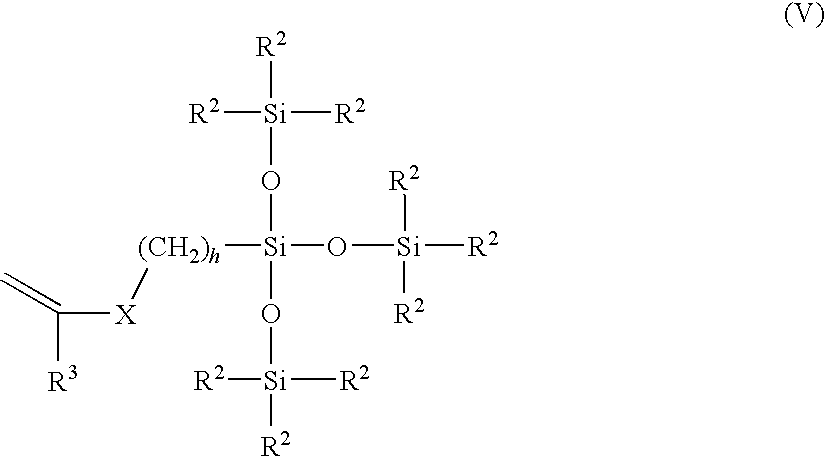Polysiloxane prepolymers for biomedical devices
- Summary
- Abstract
- Description
- Claims
- Application Information
AI Technical Summary
Benefits of technology
Problems solved by technology
Method used
Image
Examples
example 1
Preparation of α,ω-bis(4-hydroxybutyl)polydimethylsiloxane (Mn about 3600)
[0065]The following were charged to a 2-L, three-neck round-bottom flask equipped with one reflux condenser: 51.26 grams of 1,3-bishydroxybutyl tetramethyldisiloxane; 863 grams of dimethoxydimethylsilane; 126 grams of distilled water; and 14.7 mL of concentrated hydrochloric acid. The mixture was heated at 60° C. for 1 hour. Methanol was then distilled off over a 5-hour period. Then, 279 ml distilled water and 279 mL concentrated HCl were added, and the contents were refluxed at 100° C. for 3 hours. The crude product was then separated from the aqueous layer. Then, 600 mL diethyl ether and 400 mL distilled water were added, and the solution was extracted twice with 400 mL sodium bicarbonate solution (0.5%) and then with distilled water until the washing had neutral pH. The product was then added slowly into a mixture of methanol / water (406 g / 118 g). The bottom organic layer was separated, added with diethyl et...
example 2
Preparation of α,ω-polydimethylsiloxane prepolymer using PDMS of Example 1
[0066]A dry 3-neck, 500-mL round-bottom flask was connected to a nitrogen inlet tube and a reflux condenser. The following were added to the flask all at once: isophorone diisocyanate (9.188 g, 41.333 mmol) (IPDI); α,ω-bis(4-hydroxybutyl)-polydimethylsiloxane from Example 1 (114.68 g, 31.873 mmol) (PDMS); dibutyl tin dilaurate (0.327 g); and 180 mL methylene chloride. The contents were refluxed. After overnight, the amount of isocyanate was determined to decrease to 22.0% by titration. The contents were cooled down to ambient temperature. 1,1′-bi-2- naphthol (0.0144 g) and 2-hydroxyethyl methacrylate (2.915 g, 22.399 mmol) were then added and the contents were stirred at ambient until isocyanate peak at 2267 cm−1 disappeared from IR spectrum of the product. The solvent was then stripped under reduced pressure and the product was recovered (126 g). Theoretically, the prepolymer had 3 blocks containing of PDMS (...
example 3
Preparation of α,ω-polydimethylsiloxane prepolymer using PDMS of Example 1
[0067]The general procedure of Example 2 is followed, except that the molar ratio of PDMS to IPDI is 4:5, respectively. 149.6 g of prepolymer was recovered. Theoretically, the prepolymer had 4 blocks containing of PDMS (x about 4).
PUM
| Property | Measurement | Unit |
|---|---|---|
| weight percent | aaaaa | aaaaa |
| weight percent | aaaaa | aaaaa |
| weight percent | aaaaa | aaaaa |
Abstract
Description
Claims
Application Information
 Login to View More
Login to View More - R&D
- Intellectual Property
- Life Sciences
- Materials
- Tech Scout
- Unparalleled Data Quality
- Higher Quality Content
- 60% Fewer Hallucinations
Browse by: Latest US Patents, China's latest patents, Technical Efficacy Thesaurus, Application Domain, Technology Topic, Popular Technical Reports.
© 2025 PatSnap. All rights reserved.Legal|Privacy policy|Modern Slavery Act Transparency Statement|Sitemap|About US| Contact US: help@patsnap.com



